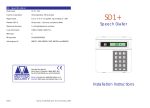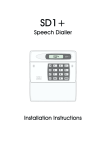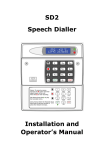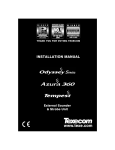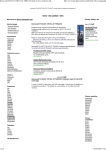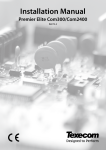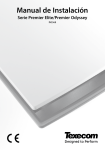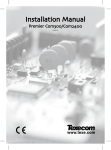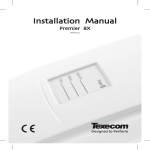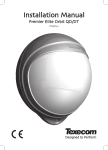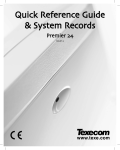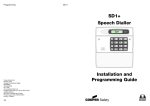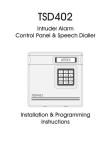Download Menvier Security TS510 Installation manual
Transcript
Installation Manual Speech Dialler/Speech & Text Dialler Issue 2 Speech Dialler Installation Manual 1. Overview Introduction Telephone Auxiliary Input Aux (4) .....Ready..... Intruder (3) PA (2) Mobile Network Fire (1) 1 2 abc 3 def 4 ghi 5 jkl 6 mno 7 pqrs 8 tuv 9 wxyz 0 Speech Dialler Telephone Network Alarm Control Panel SMS Service Centre Contact 1 Contact 2 Contact 3 Contact 4 Contact 5 Contact 6 Contact 7 Contact 8 or or or or or or or or The Speech Dialler provides a means of communicating alarm information from an alarm control panel to a standard or mobile telephone. The unit is normally connected to an alarm control panel, which provides the necessary power and battery backup. The unit is also connected to a standard telephone line and behaves like another extension to the telephone and does not affect its normal operation or that of any other extension fitted. 2 INS232-2 Speech Dialler Installation Manual Inputs: The dialler has four trigger inputs; each input can be assigned a voice message and/or a text message (Speech & Text only). The trigger inputs are normally connected to the alarm control panel communicator outputs or bell output. Other devices such as smoke detectors or temperature sensors can be directly connected to the trigger inputs. The polarity of the trigger inputs can be programmed as either +ve or -ve applied. Contacts: Up to 8 contacts may be stored in the unit; each contact can be assigned a name, telephone number, message type and acknowledgment type. !" The unit must NOT be used to call the Police via the Emergency Services phone numbers. Voice Messages: The dialler has a built-in microphone and speaker so that audio messages can be recorded and replayed directly from the unit. Up to four separate voice messages can be stored; each message can be up to 32 seconds long. Message 1 is related to trigger input 1; message 2 is related to trigger input 2 and so on. Voice messages should therefore be recorded to reflect the type of alarm that is connected to the trigger input, e.g. if input 1 is connected to the “Fire” output on the alarm/fire control panel then message 1 should state that there is a fire alarm at the premises. Text Messages: The Speech & Text model can also send text messages to mobile telephones using the SMS text service (Short Message Service). The unit does this by calling a SMS service centre, which takes the text message from the dialler and forwards it to the contact’s mobile telephone. The unit can store up to four 32character “alarm” messages and one common “site details” message. When the unit sends a text message it appends the “alarm” message to the “site details” message. The “site details” message would normally hold the name or details of the premises being protected. Acknowledgement: On receiving a voice message call from the dialler the contact person answering the call can acknowledge it at any time by pressing number [8] key on their telephone. If the voice message is not acknowledged then it is repeated ten times, after which the dialler abandons the call and dials the next available contact. Each contact can be configured to either acknowledge the call only or acknowledge and stop the dialling sequence, i.e., after pressing the [8] key on their telephone the call is acknowledged and no more contacts are dialled. Call-Abort: The dialler has several call-abort options, which include restoring the trigger input or by entering the operator’s passcode. When the unit is aborted it immediately shuts down and returns to its normal standby mode. INS232-2 3 Speech Dialler Installation Manual Outputs: The dialler has two programmable outputs that can be used to indicate the status of the unit. The outputs can also be programmed for “remote control”, this allows you to remotely turn outputs on and off with a touch-tone telephone. Listen-In Mode: When activated the listen-in mode switches the internal and remote microphones onto the telephone line so that you can hear activity at the protected site. The listen-in mode can be activated by the contact at the time of receiving a voice message or by dialling the protected site and using the Remote Access feature. Talkback Mode: When activated the talkback mode switches the internal loudspeaker onto the telephone line so that you can talk to the protected site. The talkback mode can be activated by the contact at the time of receiving a voice message or by dialling the protected site and using the Remote Access feature. Memo: The memo feature allows you to record up to 32 seconds of audio which can then be played back. This feature can be accessed locally at the unit or by dialling the protected site and using the Remote Access feature. When a new memo is recorded the unit will indicate it on the display and optionally give a beep. The memo feature can also be programmed to automatically record when a trigger input is activated. Remote Access: If enabled the dialler can be accessed remotely by dialling into the unit with a touch-tone telephone. Once connected you can turn on and off the two outputs, activate the listen-in or talkback mode, listen to the memo, or record a new memo. Remote UDL: The unit can be remotely programmed using Wintex Upload/Download software. Context Sensitive Help: When programming or operating the dialler you can press the help key and the unit will scroll the relevant information on the display. Speech Dialler Models: Two versions of the Speech Dialler are available: • Speech & Text: This model supports both speech and text messages. • Speech Only: This model only supports speech messages. 4 INS232-2 Speech Dialler Installation Manual 2. Installation General The unit requires a 12V @100mA DC power source, which is normally supplied by the auxiliary power output of an intruder alarm control panel. If the unit is not connected to an alarm control panel then a suitable power supply will be required. A 1.5 metre telephone lead is supplied with the unit, which plugs directly into any standard telephone socket. It is therefore recommended that the unit be sited as near to a telephone socket as possible. If this it not possible an approved BT extension lead may be required or the unit can be hard wired to the telephone socket using the appropriate cable. Mounting 1. Open the unit by carefully inserting a small flat-blade screwdriver into each slot at the base of the unit. Gently push the screwdriver to ease the retaining clips upward, DO NOT LEVER OR TWIST. Excessive force is NOT required. 2. Remove the front flap and front cover and unplug the loudspeaker from the main circuit board. 3. Mount the unit using at least three appropriate countersunk screws (no larger than No. 6). A keyhole slot has been provided to assist mounting and aid leveling. 4. Pass the necessary cables into the base through the cable entries and then secure the base of the unit to the wall. The telephone cable must be routed into the base using either the top right or bottom right knockout cable entry. A screw mount cable tie has been provided to allow the telephone cable to be secured to the base of the unit. The cable tie should be fitted to either the top or bottom right fixing holes. #" INS232-2 5 Speech Dialler Installation Manual PCB Layout 2 4 R1 T1 R 1 3 5 1 2 3 4 0V 12V Trigger Inputs 6 T Tamp OP1- OP2- Mic $ Telephone connections (TNV) % Tamper switch & Programmable outputs, tamper and remote microphone connections (SELV) ' Microphone ( Trigger Inputs and power supply connections (SELV) ) Loudspeaker connector (SELV) Connection terminals on the dialler are described as either “Safety Extra Low Voltage” circuits (SELV) or “Telecommunications Network Voltage” circuits (TNV). • It is important that the TNV connections are only connected to the PSTN, and SELV circuits are only connected to other circuits designated as SELV circuits. • Interconnection circuits should be such that the equipment continues to comply with the requirements of 4.2 of EN 41003 for TNV circuits and 2.3 of EN 60950 for SELV circuits, after making connections between circuits. 6 INS232-2 Speech Dialler Installation Manual Connections to the Control Panel Before making any connections to the unit, isolate ALL power from the control panel (AC mains and battery). Do not continue if there is power still present on the control panel. +12V & 0V: These terminals must be connected to the 12V auxiliary power supply of the alarm control panel. Trigger 1 - 4: These terminals should be connected to the relevant outputs on the alarm control panel. When the input is triggered the dialler will initiate the calling sequence and play the relevant speech and/or text message. The diagram below show the various wiring options for the trigger inputs: N.C. Loop +12V when active (+ve applied) N.O. Loop 1KW 1 2 3 4 0V 12V 1 Trigger Inputs 2 3 4 0V 12V Trigger Inputs 1 2 3 4 0V 12V Trigger Inputs Trigger Inputs programmed for +ve operation N.C. Loop 0V when active (+ve removed) N.O. Loop 1KW 1 2 3 Trigger Inputs 4 0V 12V 1 2 3 Trigger Inputs 4 0V 12V 1 2 3 4 0V 12V Trigger Inputs Trigger Inputs programmed for -ve operation Tamp: These terminals provide tamper protection for the dialler and should be connected to the auxiliary tamper circuit on the alarm control panel. OP1 & OP2: Two programmable switched –ve @100mA outputs. Mic: A Texecom Remote Microphone Module can be connected to this input, to enhance the listen-in mode. INS232-2 7 Speech Dialler Installation Manual Control Panel Connection Table The table below shows connection details for various alarm control panels: Trigger Inputs Control Panel 1 Fire 2 PA 3 Intruder Trigger Polarity +12V 0V A1 Advantage N/A N/A Bell - -ve Aux + Aux - ADE Accenta 6 N/A N/A B -ve 13V + 13V - ADE Concept 6 N/A N/A B -ve 13V + 13V - ADE Optima 2+ Fire PA Intruder -ve 13V + 13V - ADE Optima XM N/A N/A B -ve 13V + 13V - Ademco Infra 6 N/A N/A 3 +ve Aux + Aux - Ademco Infra 16 1* 2 3 +ve Aux + Aux - C & K 700L N/A N/A S- -ve Aux + Aux - CQR Premier 9 FA* PA IA +ve Aux 12V Aux 0V DA Abacus 6 N/A N/A Bell -ve +12V 0V DA Abacus 8 N/A N/A Bell -ve +12V 0V Gardtec 500 Series N/A N/A Bell - -ve Power + Power - Gardtec 800 Series D1* PA 12Hr -ve 12V 0V Zone 4 Zone 5 ALM -ve Aux + Aux - Menvier TS510 N/A OP 2 * OP 1 * +ve Aux + Aux - Menvier TS690R OP 1 OP 2 OP 3 -ve Aux + Aux - Menvier Networker Series Digi 1 Digi 2 Digi 3 -ve Aux + Aux - Pyronix Paragon +/E N/A N/A BA -ve Aux + Aux - Pyronix Octagon N/A PA ALM -ve Aux + Aux - Menvier TS400/TS410 Pyronix Conqueror N/A N/A BA -ve Aux + Aux - Scantronic 9448 N/A COM 2 COM 3 -ve 12V 0V Scantronic 9452/3/4/5 N/A COM 1 COM 3 -ve 12V 0V Scantronic 9750/9850 Pin 1 Pin 2 Pin 3 -ve Pin 9 Pin 8 Texecom Veritas 8 Compact N/A N/A B -ve Aux + Aux - Texecom Veritas 8/R8 N/A N/A B -ve Aux + Aux - Texecom Veritas R8 Plus Com 1 Com 2 Com 3 -ve Aux + Aux - Texecom Veritas Excel Com 1 Com 2 Com 3 -ve Aux + Aux - Texecom Premier 24 O/P 1 * O/P 2 * O/P 3 * -ve Aux + Aux - Texecom Premier 48/88/168 Digi 1* Digi 2 * Digi 3 * -ve Aux + Aux - * Control panel output may require programming to the correct function. 8 INS232-2 Speech Dialler Installation Manual Connections to the Telephone Line The easiest way to connect the dialler to the telephone line is to use the telephone lead that is provided with the unit as shown below: R1 T1 R Black T Yellow Standard BT telephone plug Connect to Earth However, if the lead is not long enough or the serial connection is required the dialler can be hard wired to the telephone socket as shown below: White/Blue BT Master Jack (NTE5) User accessible connections To other telephone extension sockets Blue/White T 3 2 1 R1 T1 R 6 5 4 Cable type 1/0.5mm CW1308 Connect to Earth #" Failure to fit an earth cable may prevent proper operation of the system and will invalidate the Texecom warranty and product approval. The telephone cable must be secured using the screw mount cable tie provided. INS232-2 9 Speech Dialler Installation Manual Commissioning 1. Once all necessary connections have been made to the unit, re-connect the loudspeaker to the main circuit board and clip the cover on to the base taking care not to trap any cables. 2. Re-apply mains power to the control panel and reconnect the battery. 3. The dialler will enter its initialisation mode (15 seconds), during which you can: • Press the red record ! key 5 times to load the factory default parameters then the " key. The display will show: “!"#$%&'()'*+,,, -"#$.#)/$&0,,,”. • Press the # key to select the language then " key to accept. 4. After the unit has finished initializing/loading defaults the display will show “,,,,1&.$2"#1,,,,”. The unit will beep once if it is a Speech Dialler and twice if it is a Speech & Text Dialler. To select the programming mode enter the default passcode of $%&'. 5. The display will show “345)67).898:6;<)!7=6>:6)186>?9@” The unit is now ready for programming and testing. Please refer to the “Operating Instructions” for full details. 6. After the dialler has been programmed and tested, secure the front cover with screw and screw cap that is provided in the spares pack. Specifications Supply Voltage: 10 - 14VDC Current Consumption: 35mA (Standby), 100mA (Active) Trigger Inputs: 4; +ve applied or +ve removed (5 - 24VDC) Outputs: 2; Open collector switched –ve @100mA Telecommunications Approval: CTR21 REN Rating: 1 Dialling Formats: Pulse or DTMF Dimensions: 140mm x 115mm x 30mm Packed Weight: 360g (Approximately) 10 INS232-2 Speech Dialler Installation Manual Standards The Speech Dialler is manufactured to meet all European Area telecommunication network requirements. These devices have been approved for use with Council Decision 98/482/EC for pan-European single terminal connection to the public switched telephone network (PSTN). However due to differences between the individual PSTNs provided in different countries, the approval does not in itself give unconditional assurance of successful operation with every PSTN network termination point. In the event of problems, you should contact Technical Support at Texecom Ltd. The Speech Dialler conforms to European Union (EU) Low Voltage Directive (LVD) 73/23/EEC (amended by 93/68/EEC) and Electro-Magnetic Compatibility (EMC) Directive 89/336/EEC (amended by 92/31/EEC and 93/68/EEC). The CE mark indicates that this product complies with the European requirements for safety, health, environment and customer protection. Warranty All Texecom products are designed for reliable, trouble-free operation. Quality is carefully monitored by extensive computerised testing. As a result the Speech Dialler is covered by a two-year warranty against defects in material or workmanship. As the dialler is not a complete alarm system but only a part thereof, Texecom cannot accept responsibility or liability for any damages whatsoever based on a claim that the dialler failed to function correctly. Due to our policy of continuous improvement Texecom reserve the right to change specification without prior notice. Speech Dialler is a Trademark of Texecom Ltd. The Speech Dialler is protected by UK and/or International Registered Design. Registered Design Number: 2089016 INS232-2 11 Texecom Limited, Bradwood Court, St. Crispin Way, Haslingden, Lancashire BB4 4PW, England. Technical Support: UK Customers Tel: 08456 300 600 (Calls charged at 3.36 pence per minute from a BT landline. Calls from other networks may vary.) International Customers Tel: +44 1278 411707 Email: [email protected] © Texecom Limited 2007 INS232-2












